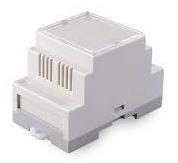This module is designed to provide I/O management for the Raspberry Pi. Apart from providing more I/O cpntrol pins, it allows the Raspberry Pi to control higher power devices outside the current and voltage capabilities of the Raspberry Pi I/O pins.
The PCA9515A is a BiCMOS integrated circuit repeater.intended for I2C bus and SMBus systems applications. The device contains two identical The PCA9515A does not support clock stretching bidirectional open-drain buffer circuits that enable I2C across the repeater. and similar bus systems to be extended without degradation of system performance. The PCA9515A buffers both the serial data (SDA) and serial clock (SCL) signals on the I2C bus, while retaining all the operating modes and features of the I2C system. This enables two buses of 400-pF bus capacitance to be connected in an I2C application.
The PCA9515A also can be used to run two buses: one at 5-V interface levels and the other at 3.3-V interface levels, or one at 400-kHz operating frequency and the other at 100-kHz operating frequency.
The TTL to RS422 converter converts the TTL serial lines to and from balanced RS422 lines. As the unit was available, it was used, even though it requires a +5V supply. To protect the Raspberry Pi from the +5V signals, two of the five (4) provided level converters are used to convert the signals between +3,3V signals and +5Vsignals.
The I/O Module is built on a 6cm x 4cm prototype board, with two (2) MCP23017 modules mounted vertically on the board. There are two (2) ULN2803a open collector Darlington arrays. One array has its flyback diodes connected to the +5V supply. This MUST be connected to the +5V rail as this also supplies power to the MCP23017 chips.
The other array can be connected to the +5V, +12V or +24V supplies to match the supply to inductive loads.
The open collector outputs may be paralleled to increase the load current that may be switched, as long as the software controls the corresponding input bit simultaneously. Each output can switch up to 350mA, while the total current for all channels should not exceed 2A.
The electronics of this device are constructed on a 5cm x 7cm prototype board. Two (2) 18-pin and two (2) 28-pin IC (Integrated Circuit) sockets are soldered onto the board, along with a 40-pin male IDC connecter that will ultimately connect to the same type of terminal strip as the Raspberry Pi uses.









